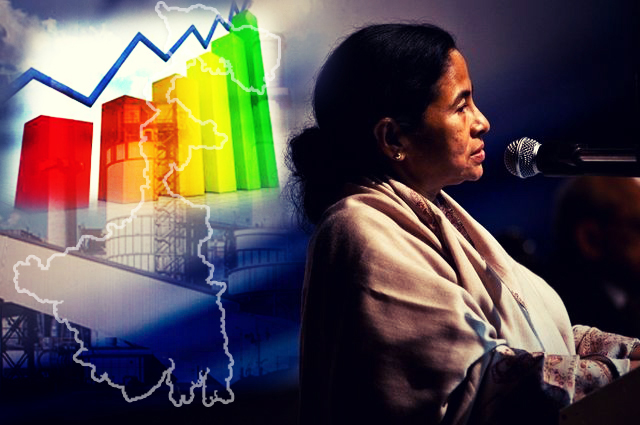The Bengal Government has been successful in increasing its earnings due to the adoption of information technology (IT) across the board.
According to data available with the State Finance Department, the earnings from stamp duty and registration have risen by 17 per cent, from customs duty, by a massive 93 per cent, from transport tax, by 26 per cent and from electricity duty, by 39 per cent. And from entry tax, during the current financial year, till date, the earning has been more than Rs 1,500 crore, which is also a big increase.
The Finance Department, under the helm of Dr Amit Mitra, with due encouragement from Chief Minister Mamata Banerjee, has set an example for the rest of the country in financial management.
According to Dr Mitra, the following of sound economic policies has enabled the State Government to steadily repay its massive debt, a legacy of the erstwhile Left Front Government.
Unlike for the Centre and many other State Governments, the adoption of the Goods and Services Tax (GST) has not led to any major shortfall in the collection of taxes by the Bengal Government. The major reason for this is again the IT-friendly tax collection structure.
Another big amount of money is due to the State Government, which would further boost the revenue – payment by the Centre to cover the losses borne by the states due to the adoption of Inter-State GST (IGST) and GST.
This highly successful integration of IT with the financial structure of the State Government has been acknowledged and appreciated by the Central Government through various awards in categories like e-taxation, e-tendering, e-governance, etc.
Comparing a few relevant numbers, the capital expenditure of Bengal has increased from Rs 2,225 crroe in 2010-11 to Rs 11,336 in 2016-17, and the plan expenditure has increased from Rs 14,615 crore to Rs 49,090 crore, during the same respective periods.
তথ্যপ্রযুক্তি ব্যবহারে আয় বাড়ল রাজস্বে
রাজস্বে তথ্যপ্রযুক্তি ব্যবহারে বিপ্লব ঘটিয়ে উল্লেখযোগ্যভাবে আয় বাড়িয়েছে রাজ্য সরকার। অর্থ দপ্তরের তথ্য বলছে, গত অর্থবর্ষে এপ্রিল থেকে ডিসেম্বরের তুলনায় চলতি আর্থিক বছরে একই সময়ে স্ট্যাম্প ডিউটি এবং রেজিস্ট্রেশন ফি–তে ১৭ শতাংশ, আবগারি শুল্কে ৯৩, পরিবহণ কর ২৬ শতাংশ এবং বিদ্যুৎ শুল্কে ৩৯ শতাংশ আয় বেড়েছে।
অন্যদিকে, প্রবেশ কর হিসেবে চলতি অর্থবছরে এখনও পর্যন্ত রাজস্ব আদায় হয়েছে ১ হাজার ৫০০ কোটি টাকার বেশি। রাজস্বে খাতে এই বিপুল পরিমাণ আয় বৃদ্ধি হওয়ার ফলে রাজ্য এখনও পর্যন্ত কেন্দ্র সরকারের নির্ধারিত ঋণ গ্রহণের সীমা ছাড়ায়নি। চলতি অর্থবর্ষে নভেম্বর পর্যন্ত রাজ্য সরকার ঋণ নিয়েছে ১৮ হাজার কোটি টাকা। যেখানে ঋণ নেওয়ার ক্ষমতা ২৯ হাজার কোটি টাকা। তথ্য বলছে, চলতি অর্থবর্ষের বাকি সময়ে রাজ্যের ঋণ নেওয়ার সুযোগ রয়েছে ১১ হাজার কোটি টাকা। নির্দিষ্ট নিয়ম মেনে চলার ফলে আর্থিক শৃঙ্খলার নজির তৈরি করতে পেরেছে রাজ্য।
এই শৃঙ্খলা তৈরি হওয়ায় রাজ্য সরকার ঋণের ওপর নিয়ন্ত্রণ তো রাখতে পেরেছেই, পাশপাশি আগের ঋণ শোধ করতে পারার ক্ষমতা তৈরি করেছে। অন্যদিকে, রাজ্য সরকার চলতি অর্থবর্ষে একবার ওয়েজ অ্যান্ড মিনস অ্যাডভান্স নিয়েছে। একবারও ওভারড্রাফট নেয়নি। রাজ্যের অর্থমন্ত্রী বলেন, ‘রাজ্য সরকার যে ঋণ নিয়েছে তার ৩০ শতাংশ খরচ করেছে রাজ্যের উন্নয়নে।’
সুষম ঋণনীতির ফলে উচ্চ সুদের হারে নেওয়া আগের ঋণ শোধ করে দিতে পেরেছে। জিএসটি আদায়ের ক্ষেত্রে যখন কেন্দ্র, বিভিন্ন রাজ্য সরকারের আয় উল্লেখযোগ্যভাবে কমছে তখন এ রাজ্যে তার প্রভাব বেশ কম। এর কারণ তথ্যপ্রযুক্তিবান্ধব কর পরিষেবা। রাজ্যের আয় বাড়ার আরও একটি পথ এখনও খোলা। সেটি হল আইজিএসটি এবং জিএসটি বাবদ কেন্দ্রের থেকে ক্ষতিপূরণের একটি বড় অঙ্কের অর্থ পাওনা রয়েছে। বড় ব্যবসায়ীরা চটজলদি নতুন কর ব্যবস্থায় (জিএসটি) নিজেদের খাপ খাইয়ে নিয়ে নাম নথিভুক্ত করাতে পেরেছেন। ছোট ব্যবসায়ীরা তা করতে গিয়ে ধাক্কা খাচ্ছেন। এই বিষয়টি অনেক আগেই বুঝতে পেরেছিল রাজ্য। আরও সময় নিয়ে জিএসটি চালুর পক্ষে সওয়াল করেছিল।
এদিকে, রাজ্য সরকার আর্থিক অপচয় যাতে না হয় সেদিকে লক্ষ্য রেখেছে। বিভিন্ন দপ্তরে পড়ে থাকা টাকা ফিরে এসেছে অর্থ দপ্তরে। তার পরিমাণ ২ হাজার কোটি ছাড়িয়েছে। আরও ২–৩ হাজার কোটি টাকা ফেরত আসার সম্ভাবনা। তথ্যপ্রযুক্তি ক্ষেত্রে রাজ্যের ভাল কাজের স্বীকৃতি দিয়েছে কেন্দ্র। অনেকগুলি ক্ষেত্রে পুরস্কৃতও করেছে। এর মধ্যে রয়েছে ই–ট্যাক্সেশন, ই–টেন্ডারিং, সুসংহত আর্থিক ব্যবস্থাপনা–সহ আরও কয়েকটি ক্ষেত্র। ২০১০–১১ সালে রাজ্য সরকারের মূলধনী ব্যয় ছিল ২ হাজার ২২৫ কোটি টাকা। ২০১৬–১৭ সালে তা বেড়ে হয়েছে ১১ হাজার ৩৩৬ কোটি। অন্যদিকে, ২০১০–১১ সালে পরিকল্পনা খাতে ব্যয় ছিল ১৪ হাজার ৬১৫ কোটি টাকা। বেড়ে হয়েছে ৪৯ হাজার ৯০ কোটি টাকা।
Source: Aajkaal

